
Opening in the summer of 2005, the Spa at Mohonk Mountain House was built from quartz conglomerate stone that was extracted from the Shawangunk Ridge on site. The spa, designed by Saratoga Associates, features a heated outdoor mineral pool where guests can relax and pamper themselves.
In keeping with the tradition of stonework at the Mohonk Mountain House in New Paltz, NY, a new spa wing was recently built with indigenous rock that was blasted on site
The location of the Mohonk Mountain House could not be more picturesque. Perched on the Shawangunk Ridge overlooking a lake in New York State's Hudson Valley region, the historic resort offers guests peace and tranquility. And its architecture, which was built from rock that was extracted from the grounds on which the establishment sits, reflects its natural setting. Recently, the addition of a 30,000-square-foot spa wing has further enhanced the allure of the Mohonk Mountain resort, and great measures were taken to ensure that the new construction matches the existing stonework.
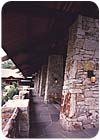
Approximately 600 tons of indigenous stone was employed throughout the building. The rustic nature of the stone reflects the resort's surrounding environment.
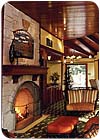
In the spa's solarium, a floor-to-ceiling fireplace creates a focal point in the room.
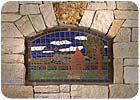
A locally crafted tile mosaic of Mohonk's signature “summer houses†adds an artistic detail to the massive stone fireplace.
“The challenge was to create a spa wing as an extension to the turn-of-the-century historic Mountain House,†explained Rudden, who said the design goal was to “make improvements without appearing to make any changes by seamlessly aligning with Mohonk's distinctive architecture, emulating neither high Victorian style nor Adirondack rustic lodge.†Rudden worked on the job with Project Architect Andy Allison, AIA, and the architects' intent for the new spa - both for esthetic and stewardship reasons - was to utilize as many natural products, finishes and local crafts as possible for both the exterior and interior.

Saratoga Associates was also responsible for the design of a skating pavilion at the Mohonk Mountain House, which opened in 2003.
Blasting the stone
By far, the most difficult aspect of this project was the removal of the tons of stone from the side of the mountain. “It was a phenomenal project - one of the most challenging projects that we have worked on,†said Senior Project Manager Michael Quattrociocchi of Storm King Contracting in Montgomery, NY. “It required a mix of many different construction methods.â€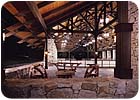
“The same process was done for the skating pavilion,†said architect Michael Rudden, AIA. “All the stone came from the footprint of the building. It was a great advantage [having the stone on site]. Also, it is nice to have indigenous stone.â€
A staging area was designated on the property, where all of the blasted stone was taken and split. “The bulk of the stone was split into veneer and palletized,†said Quattrociocchi. “It was then trucked back to the site. We left [the resort] close to 100 pallets full of stone veneer - amounting to 3,000 to 4,000 square feet of veneer coverage - which can be used for future projects. Mohonk concluded that this may be the last time that stone could be harvested out of the mountainside.
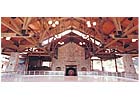
The stone veneer used in the skating pavilion is uniform with the historic stonework on the grounds, including the new spa.
Measuring seismic activity
Because blasting was close to the hotel, which remained open through the duration of the spa's construction, extensive steps were taken to ensure that the quarrying process did not affect patrons. “We had to have noise monitors because the hotel was in operation,†said Rudden. “There can't be drilling at 6 a.m. It is a pristine environment. We discovered that the vibrations increased the closer we got to the hotel, so we had to cut down the distance and take smaller bits of stone out. It became a learning curve.â€According to the contractor, blasting was within 8 feet of the Mohonk Mountain House. “We had seismic monitors within the existing building and also at the other end of the project site,†said Quattrociocchi. “One of the concerns was rock breaking off of the cliffside and falling into the lake. At times, we reached the seismic limits, so we had to employ different methods of rock removal.â€
The contractor explained that when the vibrations were too strong to use typical blasting techniques, they used a hydraulic hammer mounted on an excavator. They also would drill a series of holes into a section of rock to assist in the fracturing process it - making for easier removal.
From blasting to completion, building the new spa at Mohonk Mountain House spanned about 20 months. Over the course of the project, there were upwards of 200 people on the jobsite among all the different trades. A total of 10 to 15 workers were specifically dedicated to the stonework portion of the project.
In addition to the spa amenities, the Mohonk Mountain House features an ice skating pavilion, also designed by Saratoga Associates and constructed by Storm King Contracting. “The same process was done for the skating pavilion,†explained the architect, adding that the rink opened in 2001. “All the stone came from the footprint of the building. It was a great advantage [having the stone on site]. Also, it is nice to have indigenous stone.â€
The new Spa at Mohonk Mountain House opened in the summer of 2005, featuring 16 treatment rooms, a solarium, yoga/motion room, fully equipped fitness center, outdoor heated mineral pool and indoor swimming pool.
Spa at Mohonk Mountain House
New Paltz, NYOwner: Smiley Brothers Inc.
Architect: Saratoga Associates, Saratoga Springs, NY; New York, NY; and Boston, MA
Landscape Architect/Civil Engineer: Saratoga Associates, Saratoga Springs, NY; New York, NY and Boston, MA
General Contractor: Storm King Contracting Inc., Montgomery, NY
